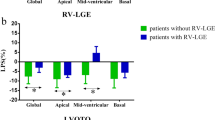Abstract
Apical hypertrophic cardiomyopathy (AHCM) has a broad phenotypic spectrum and still poses many diagnostic and prognostic challenges. Our team performed a retrospective study to examine the prognostic value of myocardial deformation obtained with cardiac magnetic resonance tissue tracking (CMR-TT) analysis in predicting adverse events in AHCM patients. We included patients with AHCM referred to CMR in our department from August 2009 to October 2021. CMR-TT analysis was performed to characterize the myocardial deformation pattern. Clinical, other complementary diagnostic exams characteristics and follow-up data were analysed. Primary endpoint was the composite of all-cause hospitalizations and mortality. During the 12-year period, 51 AHCM patients were evaluated by CMR, with a median age of 64 years-old and male predominance. 56,9% had an echocardiogram suggestive of AHCM. The most frequent phenotype was “the relative form” (43,1%). CMR evaluation revealed a median maximum left ventricle thickness of 15 mm and the presence of late gadolinium enhancement in 78,4%. Applying CMR-TT analysis, median global longitudinal strain was − 14,4%, with a median global radial strain of 30,4% and global circumferential strain of -18,0%. During a median follow-up of 5,3 years, the primary endpoint occurred in 21,3% of patients, with a hospitalization rate of 17,8% and all-cause mortality rate of 6,4%. After multivariable analysis, longitudinal strain rate in apical segments was an independent predictor of the primary endpoint (p = 0,023), showing that CMR-TT analysis could be useful in predicting adverse events in AHCM patients.
Similar content being viewed by others
References
Pu C, Fei J, Lv S et al (2021) Global circumferential strain by Cardiac magnetic resonance tissue tracking Associated with ventricular arrhythmias in hypertrophic cardiomyopathy patients. Front Cardiovasc Med 8(May):1–8. https://doi.org/10.3389/fcvm.2021.670361
Parisi R, Mirabella F, Secco GG, Fattori R (2014) Multimodality imaging in apical hypertrophic cardiomyopathy. World J Cardiol 6(9):916. https://doi.org/10.4330/wjc.v6.i9.916
Rowin EJ, Maron BJ, Maron MS (2020) The hypertrophic cardiomyopathy phenotype viewed through the prism of Multimodality Imaging: clinical and etiologic implications. JACC Cardiovasc Imaging 13(9):2002–2016. https://doi.org/10.1016/j.jcmg.2019.09.020
Hughes RK, Knott KD, Malcolmson J et al (2020) Apical hypertrophic cardiomyopathy: the variant less known. J Am Heart Assoc 9(5):1–11. https://doi.org/10.1161/JAHA.119.015294
Fattori R, Biagini E, Lorenzini M, Buttazzi K, Lovato L, Rapezzi C (2010) Significance of magnetic resonance imaging in apical hypertrophic cardiomyopathy. Am J Cardiol 105(11):1592–1596. https://doi.org/10.1016/j.amjcard.2010.01.020
Yang H, Carasso S, Woo A et al (2010) Hypertrophy pattern and regional myocardial mechanics are related in septal and apical hypertrophic cardiomyopathy. J Am Soc Echocardiogr 23(10):1081–1089. https://doi.org/10.1016/j.echo.2010.06.006
Huang G, Fadl SA, Sukhotski S, Matesan M (2019) Apical variant hypertrophic cardiomyopathy “multimodality imaging evaluation. Int J Cardiovasc Imaging 36(3):553–561. https://doi.org/10.1007/s10554-019-01739-x
Moon JCC, Fisher NG, McKenna WJ, Pennell DJ (2004) Detection of apical hypertrophic cardiomyopathy by cardiovascular magnetic resonance in patients with non-diagnostic echocardiography. Heart 90(6):645–649. https://doi.org/10.1136/hrt.2003.014969
Kao YC, Lee MF, Mao CT et al (2013) Differences of left ventricular systolic deformation in hypertensive patients with and without apical hypertrophic cardiomyopathy. Cardiovasc Ultrasound 11(1):1–12. https://doi.org/10.1186/1476-7120-11-40
Hughes RK, Knott KD, Malcolmson J et al (2020) Advanced Imaging Insights in apical hypertrophic cardiomyopathy. JACC Cardiovasc Imaging 13(2P2):624–630. https://doi.org/10.1016/j.jcmg.2019.09.010
Lee D, Montazeri M, Bataiosu R et al Clinical characteristics and prognostic importance of left ventricular apical aneurysms in hypertrophic cardiomyopathy. JACC Cardiovasc Imaging. 15(10):1696–1711
Rickers C, Wilke NM, Jerosch-Herold M et al (2005) Utility of cardiac magnetic resonance imaging in the diagnosis of hypertrophic cardiomyopathy. Circulation 112(6):855–861. https://doi.org/10.1161/CIRCULATIONAHA.104.507723
Gaudio C, Pelliccia F, Tanzilli G, Mazzarotto P, Cianfrocca C, Marino B (1992) Magnetic resonance imaging for assessment of apical hypertrophy in hypertrophic cardiomyopathy. Clin Cardiol 15(3):164–168. https://doi.org/10.1002/clc.4960150306
Ünlü S, Özden Tok Ö, Avcı Demir F, Papadopoulos K, Monaghan MJ (2021) Differential diagnosis of apical hypertrophic cardiomyopathy and apical displacement of the papillary muscles: a multimodality imaging point of view. Echocardiography 38(1):103–113. https://doi.org/10.1111/echo.14895
Kim EK, Lee SC, Hwang JW et al (2016) Differences in apical and non-apical types of hypertrophic cardiomyopathy: a prospective analysis of clinical, echocardiographic, and cardiac magnetic resonance findings and outcome from 350 patients. Eur Heart J Cardiovasc Imaging 17(6):678–686. https://doi.org/10.1093/ehjci/jev192
Li ZL, He S, Xia CC et al (2021) Global longitudinal diastolic strain rate as a novel marker for predicting adverse outcomes in hypertrophic cardiomyopathy by cardiac magnetic resonance tissue tracking. Clin Radiol 76(1):78. .e19-78.e25
CVI42 - User manual Version 5.5. Connect (2016) :1-241. https://www.circlecvi.com/docs/product-support/manuals/cvi42_user_manual_v5.5.pdf
Masao Yamada K, Teraoka M, Kawade, Masaharu Hirano AY (2009) Frequency and distribution of late gadolinium enhancement in magnetic resonance imaging of patients with apical hypertrophic cardiomyopathy and patients with asymmetrical hypertrophic cardiomyopathy: a comparative study. Int J Cardiovasc Imagin 25(Suppl 1):131–138
Pelletier R, Choi J, Winters N et al (2016) Sex differences in clinical outcomes after premature Acute Coronary Syndrome. Can J Cardiol 32(12):1447–1453. https://doi.org/10.1016/j.cjca.2016.05.018
Funding
None.
Author information
Authors and Affiliations
Contributions
R.M.F and M.B wrote the main manuscript text. R.L.L, R.F and N.D.F did the CMR analysis of all the patients included in the study, and R.M.F performed the tissue-tracking analysis. All authors reviewed the manuscript and R.F.C revised the final version of the manuscript. All authors read and approved the final manuscript.
Corresponding author
Ethics declarations
Competing interests
The authors declare no competing interests.
Conflict of interest
None declared.
Additional information
Publisher’s Note
Springer Nature remains neutral with regard to jurisdictional claims in published maps and institutional affiliations.
Rights and permissions
Springer Nature or its licensor (e.g. a society or other partner) holds exclusive rights to this article under a publishing agreement with the author(s) or other rightsholder(s); author self-archiving of the accepted manuscript version of this article is solely governed by the terms of such publishing agreement and applicable law.
About this article
Cite this article
Menezes Fernandes, R., Brandão, M., Ladeiras Lopes, R. et al. Myocardial deformation analysis using cardiac magnetic resonance in apical hypertrophic cardiomyopathy: is it an useful tool to predict adverse outcomes?. Int J Cardiovasc Imaging 39, 1997–2003 (2023). https://doi.org/10.1007/s10554-023-02902-1
Received:
Accepted:
Published:
Issue Date:
DOI: https://doi.org/10.1007/s10554-023-02902-1







